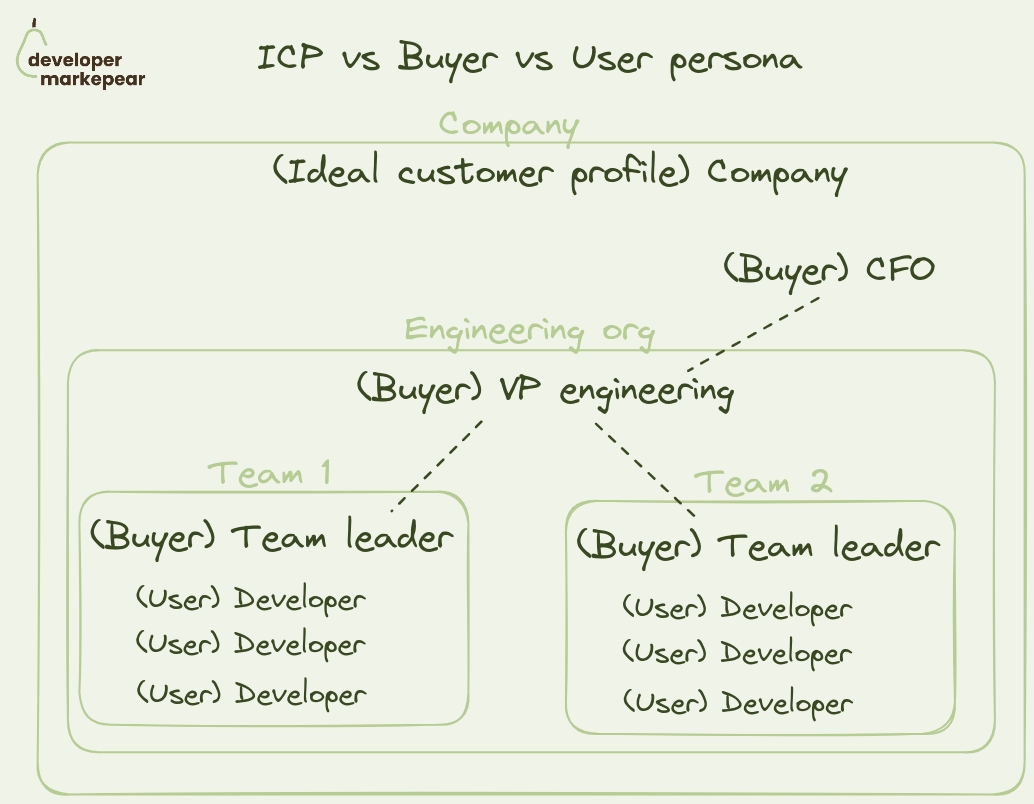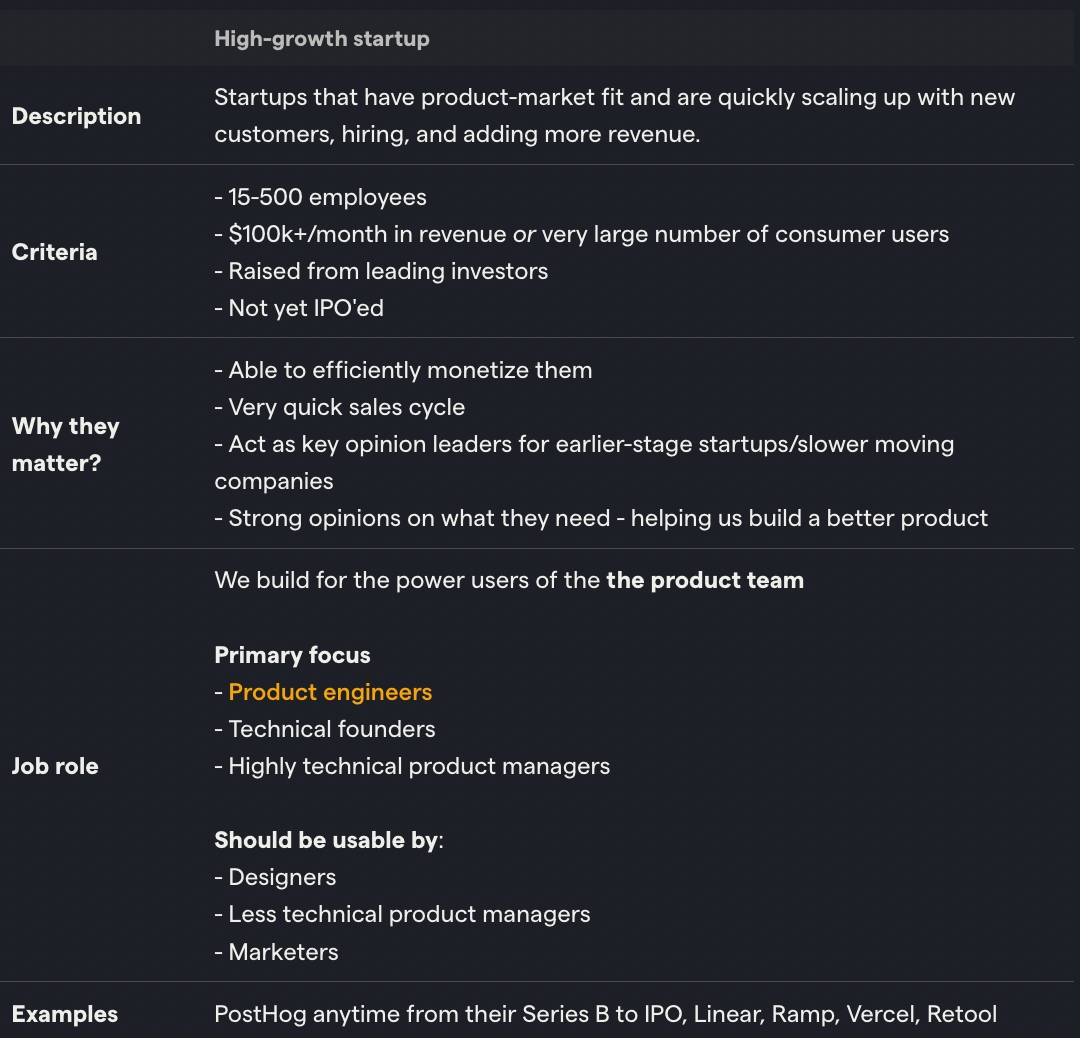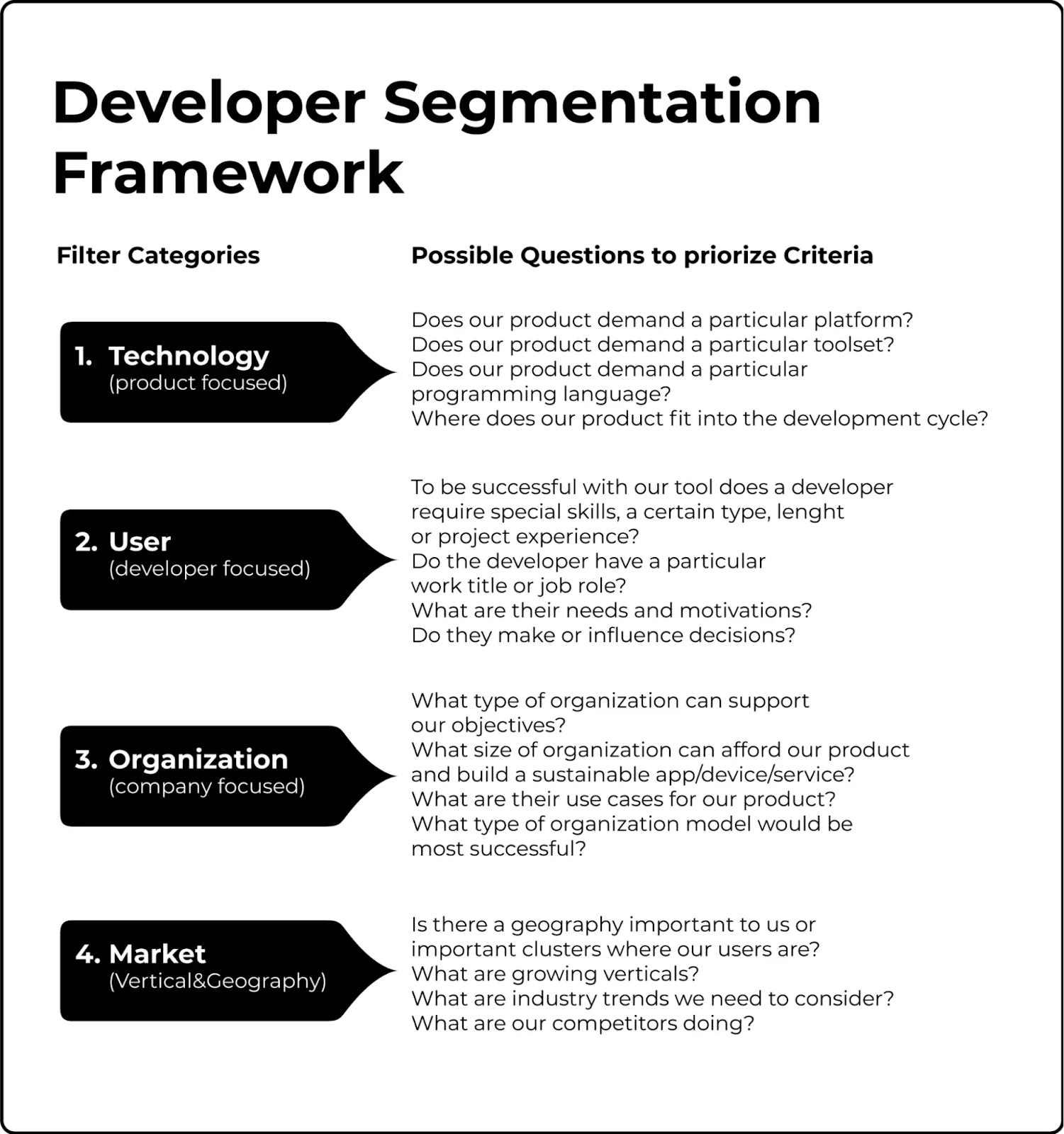👑Defining your ICP
Do you have any questions, need personalized guidance, or want to share your journey in this playbook? We'd love to talk to you. Reach out to us.
Defining your ideal customer profile (ICP) is crucial, especially when your end users are developers. It's a step you shouldn't skip before diving into your Go-To-Market (GTM) strategy. Here's why it matters:
Tailor Your Product: Knowing your ICP helps you fine-tune your product to meet the specific needs and preferences of developers. By focusing on what matters most to them, you can enhance your product's appeal.
Optimize Resource Allocation: Identifying your ICP enables you to allocate your resources—time, budget, and manpower—more effectively. Rather than spreading yourself thin, you can concentrate on areas that will yield the highest return.
Communicate Effectively: Understanding your ICP allows you to speak their language. By addressing their pain points and priorities, you can craft messaging that resonates with developers, improving your marketing efforts.
Get to "Project market fit" quickly: When your product aligns with the needs of developers, it's easier to gain traction in the market. This accelerates your path to success and profitability.
People also often mix up personas and ICPs, but they're actually different concepts. User personas and buyer personas or ideal customer profiles (ICPs) aren't synonymous, as the latter may not even be users of your product.
When you consider a typical dev tool go-to-market-motion you have:
User Personas: These are the individuals who will actually use your product on a day-to-day basis. For developer tools, user personas may include software engineers, system architects, DevOps engineers, or technical leads. They understand the tech side of things, you don’t need to (or shouldn’t) speak about decreasing developer attrition or reducing enterprise risks. This is not what they (typically) care about.
Buyer Personas: The person who sign off on that purchase. In the context of developer tools, buyers could be team leaders, VPs of engineering, CTOs, or even CFOs, depending on the organization's structure and procurement processes. It's crucial to understand their priorities, concerns, and decision-making criteria to tailor your messaging and value proposition effectively.
Ideal Customer Profile (ICP): Companies that ultimately buy your product. The ICP represents the characteristics of the companies or organizations that are the best fit for your product. This goes beyond individual personas to encompass factors such as company size, industry vertical, technological stack, and strategic priorities. Identifying your ICP helps you target your sales and marketing efforts towards organizations that are most likely to derive significant value from your developer tools.

Some questions to ask while defining your persona?
Here's a list of things you can begin with:
Job Summary:
What specific programming languages, frameworks, or technologies does the developer work with?
What are their primary responsibilities in their role as a developer? For example, are they responsible for front-end development, back-end development, or full-stack development?
Motivation:
What are the developer's career aspirations or professional goals?
What motivates them to excel in their role as a developer?
Example: The developer's motivation is to stay updated with the latest industry trends and advancements in front-end development to enhance their skills and advance in their career. What do they read?
Frustrations:
What challenges or obstacles does the developer face in their daily work?
What impediments prevent them from achieving their development goals efficiently?
Personal Skills & Traits:
What positive attributes or traits characterize the developer's personality and work ethic?
How do these qualities influence their approach to development tasks?
Key Tools:
What software tools or development environments does the developer rely on to complete their tasks effectively?
Example: The developer utilizes Visual Studio Code as their primary code editor and GitHub for version control and collaboration with team members.
Workflows:
What are the typical steps or processes the developer follows when working on a development project?
Example: The developer's workflow involves initial project planning, followed by iterative development, code reviews, and continuous integration/continuous deployment (CI/CD) processes.
Collaborative Teams:
Are there specific teams or individuals within the organization that the developer frequently collaborates with or relies on for support?
Example: The developer collaborates closely with the design team to ensure seamless integration of UI/UX components into the final product.
Presence:
Where does the developer typically engage online for professional development, networking, or seeking assistance?
Example: The developer is active on developer communities like Stack Overflow and participates in online forums and Slack channels dedicated to front-end development discussions.
If it helps you visualize your user, you can also include other information such as workflows, tools, or jobs to be done.
Another Developer Segmentation Framework
This is from Caronline Lewko (CEO, Revere communications). Read about it here. It divides characteristics by:
Technology (product-focused)
User (developer-focused)
Organization (company-focused)
Market (vertical&geography)
Gitlab also posted their framework:
If you're looking for more examples, GitLab has published the 16 different user personas they use.
What are the benefits of user personas?
More empathy for your users: User personas highlight their needs, goals, and frustrations. This ensures that your work is aligned with what they genuinely require, leading to better products.
Better team communication: By providing a common understanding of who your target users are, user personas enable clearer discussions about their needs and experiences.
Strategic alignment: A well-defined user persona acts as a north star for teams, guiding product development, marketing strategies, and customer outreach efforts.
How to identify your ICP
To identify your own ICP, go through the list below and take your best guess at picking the three most unique and important characteristics of your potential ideal customer (here’s a template to get you started):
Company size (e.g. 1,000-5,000 employees)
Job title (e.g. engineering manager, social media manager)
Pain point you’re solving (e.g. compliance, internal transparency)
Company’s unique way of working (e.g. design-driven, operationally heavy)
Specific tech used (e.g. data warehouse, GitLab)
Type of business (e.g. B2B SaaS, e-commerce)
Price point (e.g. sells software that’s $10k ARR)
Geo (e.g. urban centers, LatAm)
A unique place the user spends time (e.g. Node.js community)
You can break down yoour ICP into three categories:
Things our customers need
Things our customers have
Things our customers don’t need
Get super specific about who your Ideal Customer is, even if it takes time. Don't worry if it's not clear right away, but the sooner you figure it out, the better.
“I didn’t think about ICPs whatsoever. However, looking back, that’s part of the reason PMF took so much time.” —Boris Jabes, co-founder and CEO of Census
“We did not think about ICP. I wish we did earlier on. It’s one of my biggest mistakes.” —Mathilde Collin, co-founder and CEO of Front
“We did the ICP exercise 17 times in the early days. So many times. Because at that time, all of the advice we ever got was like, ‘Know your ICP.’ So we kept trying to know who it was, and I also desperately did not want our ICP to just be startups. So we tried a lot. I think in earnest we never really had one, but we tried for sure.” — Rick Song, co-founder and CEO of Persona
Example ICP from PostHog:

Example: ToolJet
When ToolJet starts by defining its ideal customer profile (ICP). They look for companies that:
Require advanced internal tools for their operations.
Have a sizable development team.
Operate in industries where data security and compliance are crucial.
Show interest in low-code or no-code solutions.
By narrowing down these criteria, ToolJet can focus on companies that are more likely to benefit from their enterprise features.
"We focus on companies that need advanced internal tools and have the infrastructure to support them. This includes industries where data security and compliance are critical." - Navaneeth, Founder of ToolJet
Your entire GTM Strategy is downstream of your ICP
TL;DR: Your ICP will influence every decision you make.
An accurate ICP will define not just which customers you target, but every aspect of your product and go-to-market strategy. It’s the sun around which product, marketing, and sales orbit.
Here are some of the decisions companies like PostHog have made because of their ICP:
An engineering-led culture
Selling features, not benefits
Transparent, usage-based pricing
Being product-led with no outbound sales
A UI that feels like a dev tool, not an analytics tool
A focus on high-quality content for engineers and founders
Not running advertising cookies and retargeting campaigns
An unconventional website full of code snippets and memes
Building dev-focused features (e.g. dark mode, SQL querying, data warehouse)
From Lenny's Newsletter:
Most founders initially got their ICP wrong.
Everyone landed on at least three attributes to describe their ICP.
Data from outbound sales is the best signal for what’s working, versus leads from investors and friends.
There are four common signs that you’re getting closer to your ICP:
A significant increase in your conversion rate
A significant increase in enthusiasm
A much stronger desire to take action now
Learn to identify real enthusiasm
The signs of product-market fit and a company in your ICP are basically the same. Look for people / companies who:
Show visible excitement when you demo the product.
Strongly agree when you describe the problem you’re solving.
Constantly give you feedback on things you can improve.
Spontaneously invite colleagues to your demo / to use your product.
Use the product a lot even if it’s a bit janky.
Refer other people / companies they know have the same problem.
Start paying or actively want to pay (even if you’re not charging yet).
Share your product publicly – e.g. on Twitter, LinkedIn etc.
Don’t undervalue cold outbound 📨
“It gives you a very good sense of how something resonates. On the other hand, if you get a warm intro, people will take the call and maybe ask for a demo. It’s very non-committal and vague, and [it’s] harmful to startups because it can make them think they have product-market fit when they don’t.” – via The Review
Last updated
Was this helpful?

